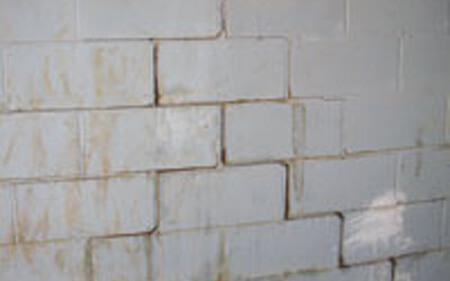Leaking mortar joint

It is not uncommon for mortar joints in a cinder block , stone, or brick foundation wall to eventually let water inside the home. Water has two possible paths when a home has this kind of foundation. It can enter directly through the cinder block, stone, or brick itself, or it could get inside through gaps in the mortar itself. Typically, this is a problem that is going to be caused from the age of the home, or from very poor workmanship during the time when the home was being constructed. If you have a very old home, the mortar joint is going to become very weak over time due to weathering, and the natural wear and tear that a home goes through over the years. And if the people who built your home didn't do a very thorough job of applying the mortar, it's only a matter of time before water seepage finds the weakest point in the wall and gets into your home.
Along with having a leaking mortar joint, it is also not uncommon for the foundation wall to have areas of porous concrete - this being the case with cinder block foundations. When there is an area of weakened concrete, water will also be able to get in through this damaged spot, and this is usually the case in homes that were built using poor construction techniques or materials.
Eventually, all of this moisture is going to cause problems in and around the home. It may also eventually cause a cinder, stone, or brick foundation wall to bow into the home because of all the water pressure. This can cause a lot of expensive damage for a home's structural integrity.

Warning Signs of A Mortar Joint Leak
If you notice any of the following, then it is a good indication that you have an area in your wall that is letting moisture into the home:
- Certain bricks, stones, or cinder blocks in the wall appear to be wet.
- Certain bricks, stones, or cinder blocks appear to be deteriorating much faster than the surrounding wall.
- Noticeable water stains appear on the wall itself.
- Puddles of water can be seen on the ground at the base of the wall with wet bricks, stones, or blocks.
- Mold can be seen growing on a certain section of the foundation wall.
Repairs for Leaking Mortar Joints
To fix the problem, interior drainage systems can be installed to collect water from the perimeter of the basement. Most interior drain tile systems are able to accumulate water from the walls and floors, and then send it off into a sump pump where it will eventually be pushed out from the home. The drainage system is installed without very much excavation in the home, and it will be effective at keeping the floor dry and safe.
On the outside of the home, the cracks in the masonry can be fixed with an epoxy or polyurethane injection technique. The crack will be filled and sealed off so that moisture can't get into the home again. Additionally, an exterior waterproofing membrane can be installed on the weakened areas of the foundation wall. The membrane has tiny holes or "dimples" on its surface which will channel water down into a drainage system so that it can't get into the basement environment and cause problems.
